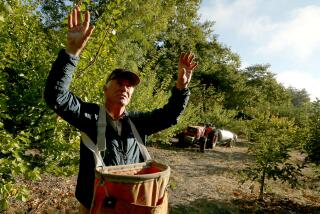After the Deluge, a Brighter Outlook for State’s Farmers
- Share via
Across Ventura County, this winter’s storms destroyed crops, smashed fences and flooded roads. But for Rob Frost, the record rainfall was a stroke of luck.
For the first time in six years, the cattle rancher reckons, there will be enough forage and water on his Santa Paula Canyon land to increase his herd of beef cows.
“We are going to recover pretty well,” he said recently. “We have great grass and deep moisture in the soil. It looks darn great.”
In fact, the clouds really did have a silver lining: California’s $30-billion farm economy, long plagued by drought, is generally benefiting from the wet weather. The pounding rain turned out to be “not the catastrophe it seemed like at the time,” said Hector Gutierrez of Otilio Farms, who grows 73 acres of strawberries near Camarillo.
From the wheat fields of Winchester in Riverside County to the strawberry farms of Oxnard, the rains flushed salts and other chemicals out of the soil, reducing the need for irrigation and creating healthier, robust winter crops.
“The berries look beautiful,” said Abby Taylor, spokeswoman for the California Strawberry Commission in Watsonville.
The office of the Ventura County agricultural commissioner at first estimated that the storms had inflicted about $20 million in damage to the local strawberry industry, but now the losses appear to be smaller.
In January, Ventura County strawberry farmers saw sales decline by about 156,000 trays from the same period a year earlier, according to the strawberry commission. Factoring in the 9% growth in strawberry acreage in the region over the last year, the damage probably amounted to $5 million to $10 million in lost sales, based on U.S. Department of Agriculture price data.
Claire Smith, a spokeswoman for Sunkist Growers Inc., the giant Sherman Oaks-based citrus cooperative, said there were scattered reports of lost trees and damaged fruit. But she added: “We needed water and rain. It helps the trees, the fruit and the soil.”
In Winchester, Andy Domenigoni figures he has saved at least $10,000 on irrigation expenses over the last two months for his 3,000 acres of wheat, alfalfa and hay. And although he irrigates some of his crops, Domenigoni grows 2,500 acres of dry-land wheat -- relying on rainfall and residual moisture in the soil.
“We weren’t able to harvest much at all last year,” he said, “but this year looks good.... The rain is a gift.”
Indeed, the Coachella Valley Water District, which serves about 60,000 acres of farmland in eastern Riverside County, sold growers 4,604 acre-feet of water last month, down from 11,638 a year earlier.
“Farmers don’t need to buy water when it is falling from the sky in buckets,” said Bob Walsh, spokesman for the U.S. Bureau of Reclamation in Boulder City, Nev. The bureau has been able to keep more water in Lake Mead, raising the level of the lake about 4 feet higher than it had expected.
Of course, when it comes to the weather, predicting isn’t easy. Lake Mead is only 58% full, and Walsh said it would take about a decade of average precipitation in the Rockies and the West to bring the water system back to normal.
On the other hand, the Sierra Nevada snowpack -- which when it melts provides much of the water for California’s reservoirs and aquifers -- is about 160% deeper than average.
In any event, farmers know that the weather could quickly turn blistering and dry and stay that way, withering the land.
“A hot east wind will suck the moisture right out of the ground,” said John Harvey, owner of H Cattle Co. in Oxnard, which has 7,000 acres of ranchland in Somis and near Moorpark. “What we need is slow steady rain, not everything all at once.”
For now, though, the mood in farm country is pretty upbeat.
“Since November we have had green grass from the Oregon border to the Mexican border,” California Cattlemen’s Assn. spokesman Ben Higgins said. “It is unprecedented.”
Grazing grass governs how many animals that ranchers can raise and how fat each animal grows, Higgins said, and “every extra pound equals a dollar and some change in the rancher’s pocket.”
As rancher Frost in Santa Paula Canyon sees it, the bubbling springs and rushing creeks on his land tell the story.
“This,” he said, “is going to be a good year.”
More to Read
Sign up for Essential California
The most important California stories and recommendations in your inbox every morning.
You may occasionally receive promotional content from the Los Angeles Times.














